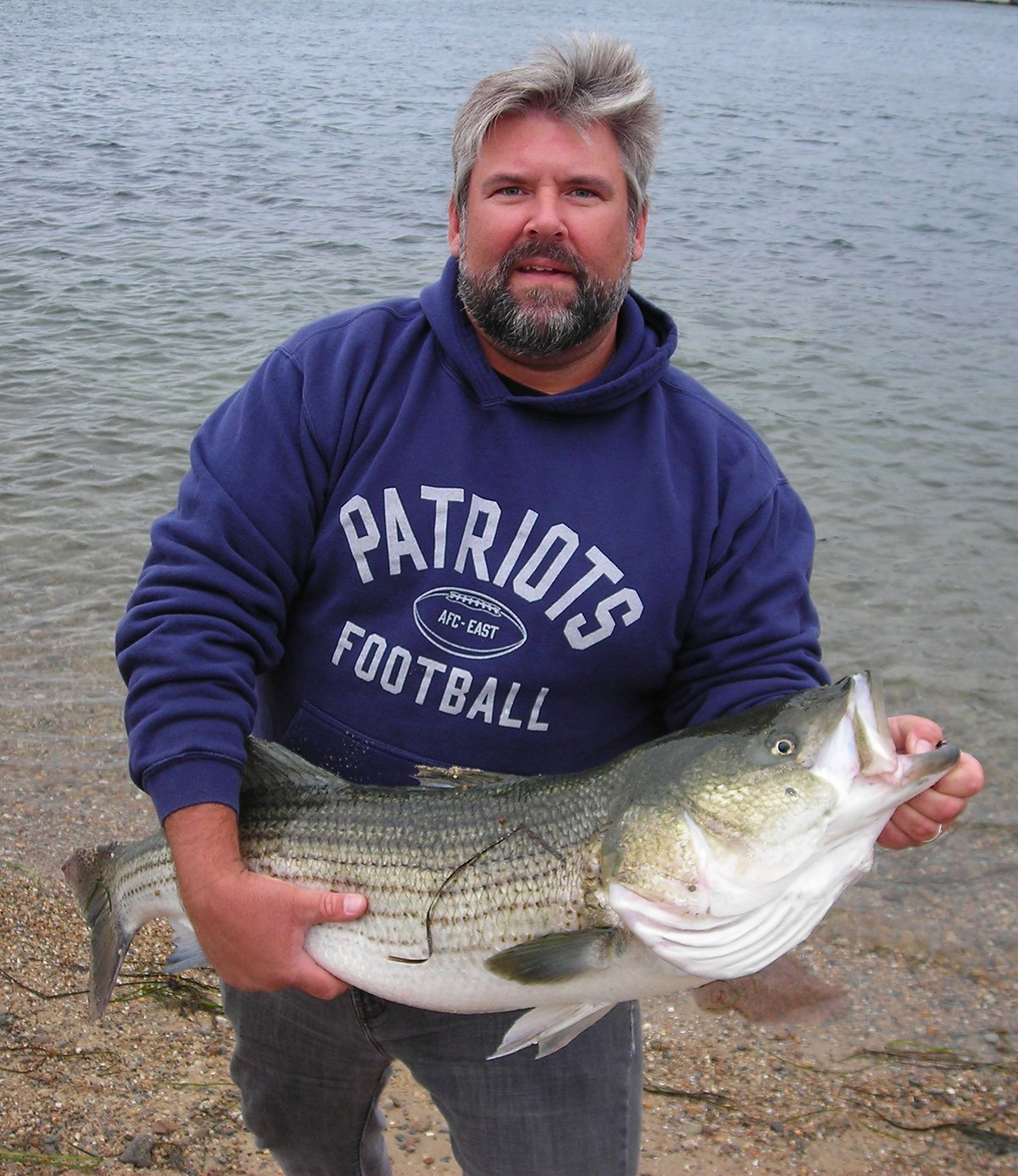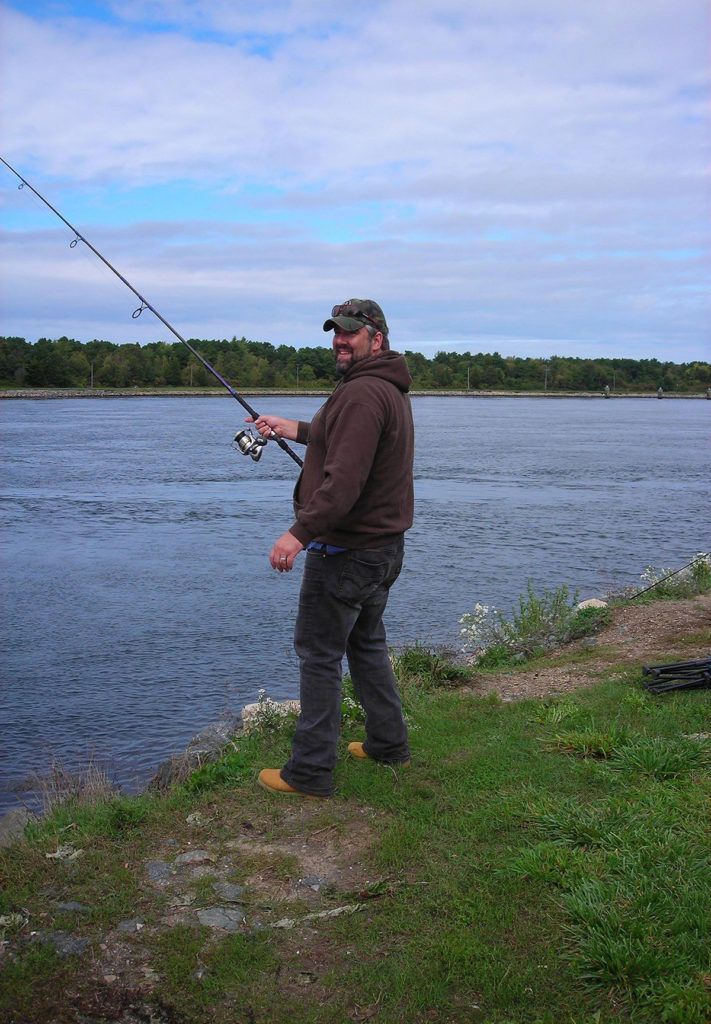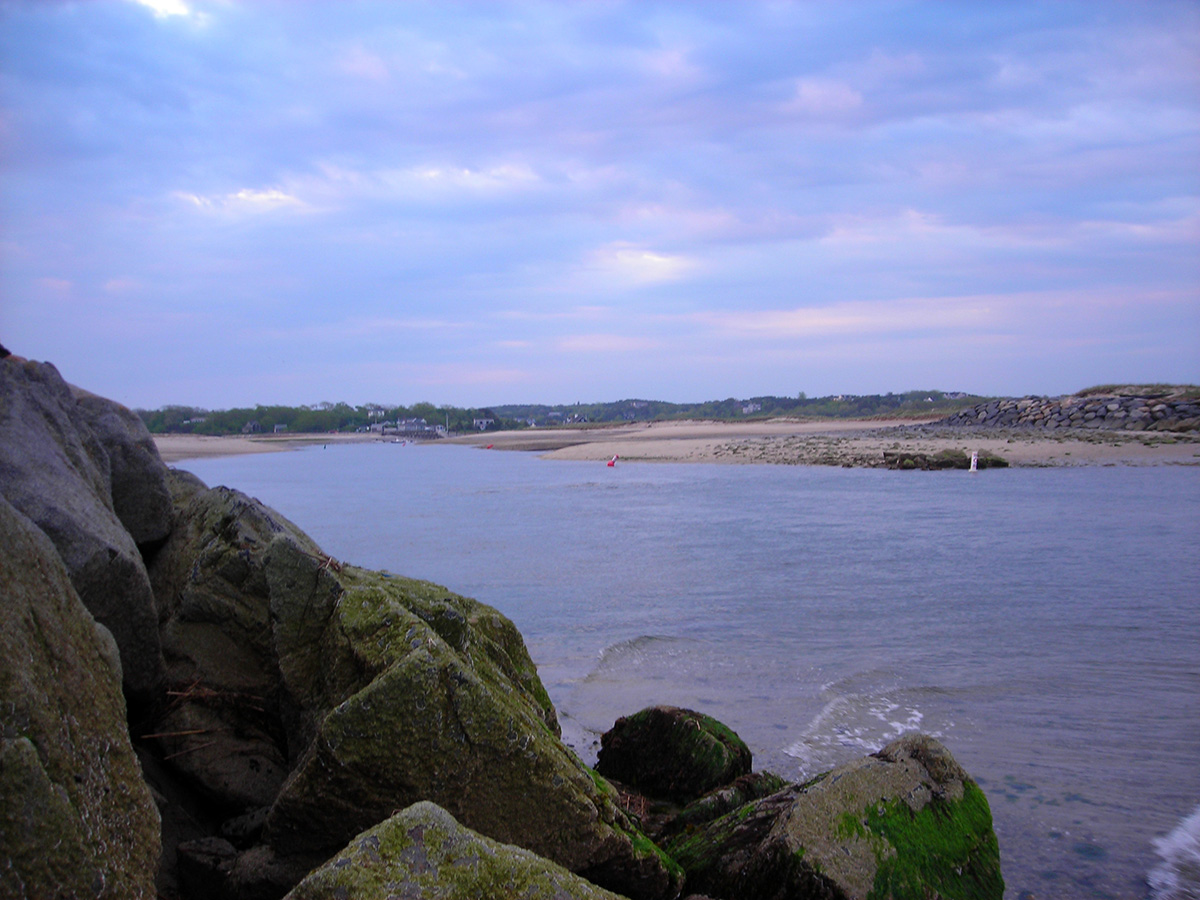
My longtime fishing buddy, John Rice and I were enjoying a bucket of steamers and a couple of cold drinks from the New Seabury Raw Bar, the famous, or some may say infamous, establishment that has long been a standard to the neighborhood tucked away on the south side of Cape Cod. The Raw Bar had become a regular stop for us during our 30-year tradition of chasing the early bluefish that frequent Nantucket Sound each spring; and after a day spent battling 10- to 12-pound blues, a rum punch, steamed clams, a friendly bar, and the Red Sox were a perfect capper to a bluebird, May day. Or so I thought.
The previous evening we ventured out in search of longfin squid, hopping from dock light to dock light armed with various squid jigs. In short order, we headed home with a couple dozen soon-to-be-frozen squid for later use. According to John, he suggested that “later use” be that night when the tide turned and started dumping bait-rich waters past the hungry stripers we knew would be waiting.
Years ago, prior to the ban on the taking of bluebacks and alewives, we would’ve opted for a river herring. Indeed, had we the chance to get out and load up on the herring we heard was making an appearance, we would’ve chilled up a few, but squid it was. That’s the beautiful thing about striped bass. While they may be keyed-in on the striper candy of springtime—herring—a hungry fish is a hungry fish and generally they’ll take any bait thrown their way be it mackerel, pogies, herring, squid, and on and on. The squid was fresh-frozen, and John and I hoped for not just hungry fish, but “haaannngrryy” fish (Hungry and angry, as my wife puts it.). And so we finished up our refreshments, passed along our thanks to Bob, the legendary proprietor of the Raw Bar, and headed out into the cooling night in search of jumbo linesides.
The beautiful weather of earlier in the day faded with the sunset, and as the tide began to ebb the skies opened. By the time we pulled up to our deserted lot we were in a heavy deluge worthy of an ark. It’s amazing how even the worst of conditions don’t seem so bad when you know there are hungry fish waiting on a blue-plate special, or in this case, tasty squid tubes. A short walk later, we were in place at our designated bottleneck where we diced up the first squid into bite-sized morsels. Our setup consisted of typical surf rods, with 2- or 3-ounce egg sinkers threaded onto the main line, attached to a swivel, and trailing a leader of approximately 40 to 42 inches. At the business end, a 5/0 bait hook took care of the rest.

A cast at about 11 o’clock, deep into the channel, got the bait down and tapping bottom every few feet or so until the current swung it up and to the side out of the current. My first cast never made it up and out of the current. Half way through my drift, I felt the unmistakable tap-tap as a striped bass sucked in my offering. Rearing back, I came tight to a decent fish, its tail whacking the line as it headed towards the Sound. With the current adding to the battle, even a small fish felt like a beast, but it was clear this was no schoolie. After a short tug-of-war, I slid a beautiful 38-inch fish into the shallows.
The key to this bait-bounce bonanza was in keeping the bait moving. This isn’t your standard, cast a weighted bait, put the rod in a sand spike and sit back in your beach chair with a beer type of fishing. This was more like eel fishing, or even jigging. You want the bait moving, and close to the bottom, experimenting with the weights until you find the zone, which is exactly what John was doing minutes earlier right before he hooked up to another nice bass of 36 inches. Once we found the right combination of weight, it was hit after hit that soggy night until we were left with one tiny scrap of squid, which unsurprisingly turned into one last bass. To say we slayed is putting it mildly, and admittedly, some of our success was where we were, but more importantly, the zone. Although the zone can sometimes be difficult to fish.
Being in “the zone” can be a simple exercise, especially in a relatively smooth, sandy bottom such as those that are encountered along the inlets of Nantucket Sound. But what of those found in not so accommodating locales, like misshapen jetties where years of pounding have shaken more than a few boulders into the channel? Or those inlets that, at first glance, appear to be somewhat snag-free, but hidden beneath the steel-blue ripples a mine field awaits, set to add to its collection of hooks and lead.
Let’s face it, you will lose gear fishing these locations; the key is to not lose more the next time, and even less the time after that. Study and learn your spots. Where are the true “no-cast” zones? Is there a fishable stretch just down-current of these danger zones? This is your challenge, should you choose to accept it. Some of these areas give up big fish; those slobs hiding in the relief of the same structure you’re avoiding. The key is to get your bait into this zone without getting hung-up on just what makes it so attractive to Mr. Linesides.
One of the most treacherous, yet most productive examples of this, is none other than the Cape Cod Canal. Everyone reading this undoubtedly knows of the Canal and its reputation as a big-bass producer. There are the jig guys, the topwater crew and the guys that soak mackerel chunks at slack tide. Each of these approaches produces bragging board specimens, but if you are looking to add the bait-bouncing tactic to your Canal quest, you need to alter the approach that would otherwise be well-suited for the aforementioned sandy inlets. I recommend shortening your leader (consider 10 inches less than previously noted) so it has less chance of wrapping a rock.
Secondly, experiment with your weights. You still want to maintain an occasional tick off the bottom, so you need to use various sizes until you get it right depending on the current and depth of your chosen spot. And speaking of current, I generally avoid the periods of tide when it is ripping at light speed, preferring to focus my effort when the current is slowing down. This is not only easier to fish, but also makes it easier for the fish to venture into the current for feeding. One trick I use when conditions dictate is to pin my egg-sinker to my line with a toothpick. This helps in areas of particularly choppy bottom by keeping the weight close to the bait, bouncing along. Finally, I know most anglers have made the switch to braid over the years, but these rocky spots are made for mono, so, if possible, keep a rig for such occasions. Braided line will part on a sharp rock faster than a Tom Brady, 4th quarter comeback, and you don’t want to be on that losing end!
Taking my recommended playbook to heart, John Rice and I put our game plan to the test on a recent Canal excursion and readied for battle. Reports had been trickling in through the cracks in the secret society of Canal rats that some serious striped visitors were showing on the West End. We pulled into a well-visited location, while some folks enjoyed their lunch break and others took a few fruitless casts, not truly committed to the effort.

The fish were there, or would be shortly with the tide and bait they were chasing. We waited, taking a few drifts, testing the hole we knew existed directly in front of us, and the hazards nearby, hidden beneath the flooding current. The wait was short as John’s fresh pogie chunk was taken in a vicious hit, and the fight was on resulting in a hearty run and a battle of give and take soon gave way to a nice fish in the high 20-pound range. My first cast following John’s fish and release transmitted the tell-tale tick and tap along the rocky bottom, and then nothing. Suspecting my bait had been picked up, I reared back and was tight to a nice fish of my own in the same size class from the same honey hole. My mono line resonated with the tail-whacking of a beautiful 43-inch striper, and soon thereafter, with a few quick pics, the fish was free to fight another day. We bait-bounced our way to a few more bass before the tide died and the bite was over, more than satisfied under the watchful eyes of the lunch-pail audience over our shoulders.
If you’re looking to add a new tactic into your bass-hunting portfolio, or possibly revisit an old favorite, rig up for some bait-bouncing action, hit those currents, and I’ll see you in the suds.



